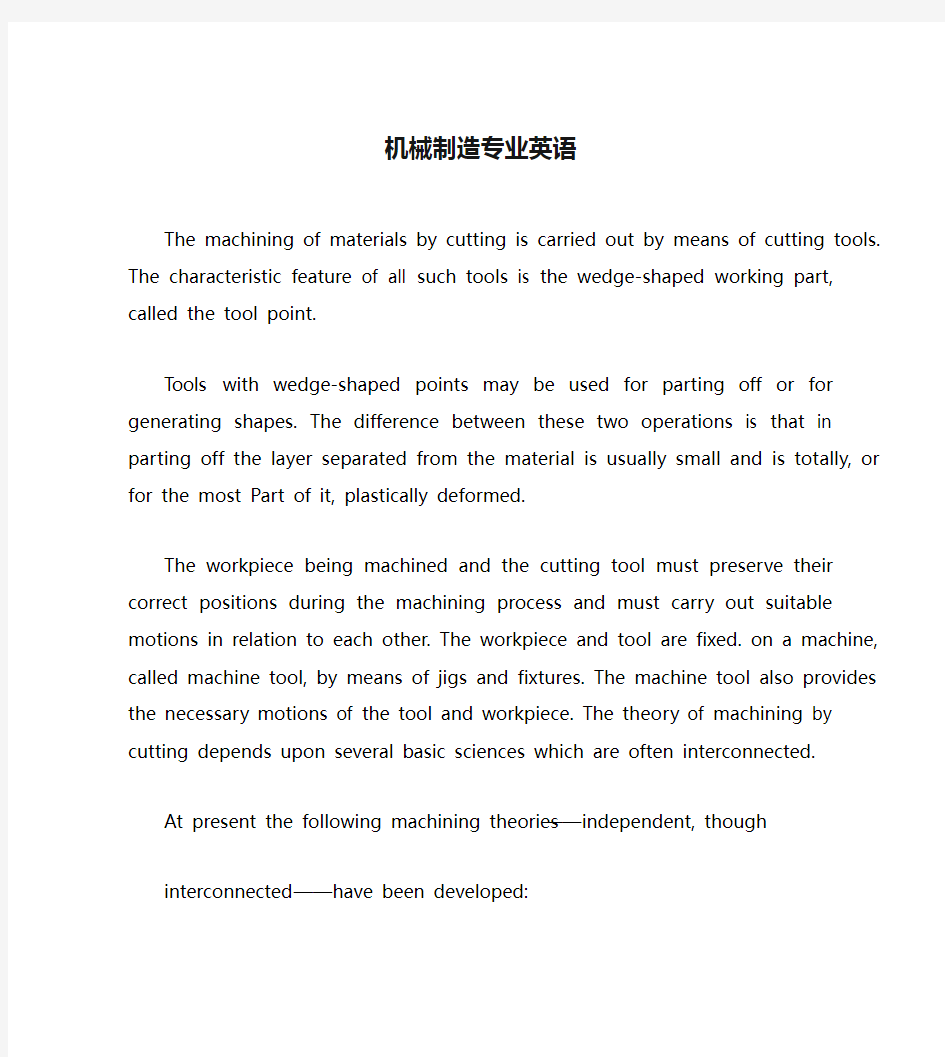机械制造专业英语

- 1、下载文档前请自行甄别文档内容的完整性,平台不提供额外的编辑、内容补充、找答案等附加服务。
- 2、"仅部分预览"的文档,不可在线预览部分如存在完整性等问题,可反馈申请退款(可完整预览的文档不适用该条件!)。
- 3、如文档侵犯您的权益,请联系客服反馈,我们会尽快为您处理(人工客服工作时间:9:00-18:30)。
机械制造专业英语
The machining of materials by cutting is carried out by means of cutting tools. The characteristic feature of all such tools is the wedge-shaped working part, called the tool point.
Tools with wedge-shaped points may be used for parting off or for generating shapes. The difference between these two operations is that in parting off the layer separated from the material is usually small and is totally, or for the most Part of it, plastically deformed.
The workpiece being machined and the cutting tool must preserve
their correct positions during the machining process and must carry out suitable motions in relation to each other. The workpiece and tool are fixed. on a machine, called machine tool, by means of jigs and fixtures. The machine tool also provides the necessary motions of the tool and workpiece. The theory of machining by cutting depends upon several basic sciences which are often interconnected.
At present the following machining theories——independent, though interconnected——have been developed:
(a) cutting of materials, particularly of metals, in various media; this theory has considerable fundamental importance,
(b) machine tool design (kinematics and dynamics),
(c) cutting tool design and the study of tool materials,
(d) design of machining jigs and fixtures,
(e) dimensioning and workshop measurements (workshop, metrology).
The theory of metal cutting comprises:
—research and scientific induction concerning the phenomena of the cutting process, based on the principles of physics and other basic sciences, —research on important practical characteristics of cutting, comprising: cutting forces and energy, cutting heat and temperature,
tool wear, geometrical and physical properties of the surface layer
being machined, workpiece accuracy and the kind of waste produced (chip), —preparation of instructions for a scientifically and technically justified choice of machining conditions, in order to optimize the industrial machining process.
(2)
Turning is a method of machining by cutting in which the workpiece carries out a rotary motion and the tool a plane linear motion.
Depending on the orientation of the axis of workpiece rotation, horizontal turning (shortly called turning because of the commonness of
its application) and vertical turning are distinguished.
Both the outer and inner surfaces can be turned. Turning of outer surfaces is called external turning. Turning of inner surfaces is called internal turning or boring.
Further division of turning into various types 'is carried out on
the basis of the mutual situation of the basic motions.
The basic motions of turning are:
